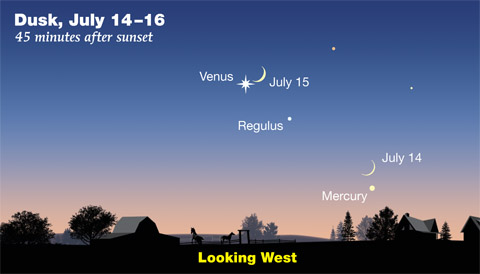This month's astronomy podcast tells you how to spot a five bright planets — Mercury, Venus, Mars, Jupiter, and Saturn — in the evening sky.
For several months you've needed to get up early to see some of the bright planets. But during July, all five of them will be making an appearance in the evening sky, though not all at once.

Sky & Telescope
Venus is still dazzling in the west after sunset. Through mid-month you can use this beacon to guide your eyes toward the planet Mercury, which has popped into view to the lower-right of Venus. The best nights to look are around July 11th and 12th, when Mercury appears farthest from the Sun and thus will be easiest to spot.
But by about 10 p.m. Venus and Mercury are both long gone, and the spotlight will pivot toward the giant planets Jupiter and Saturn. Jupiter is almost due south at nightfall, unmistakably bright and rather isolated among the dim stars of Libra. The King of Planets is roughly halfway between the bright stars Antares, to its left, and Spica to its right.
Antares, in turn, is about halfway between Jupiter on its right and Saturn, on its left. In late June, Saturn reached opposition — a point opposite the Sun in the sky — and throughout July it creeps higher up after sunset night by night.
If you’re up late enough, keep an eye on the eastern horizon for Mars, which is well up by midnight. This month the Red Planet reaches opposition on the night of the 26th. A half week later, on the night of 30th, Earth and Mars are just 35.8 million miles apart. The Red Planet hasn’t been this close to us in 15 years.
There more to see in the nighttime sky. So to get all the celestial highlights in the weeks ahead, play or download this month's 8-minute-long astronomy podcast (linked below).
Podcast: Play in new window | Download
Subscribe: Apple Podcasts | Google Podcasts | Spotify | Email | RSS | More
 0
0
Comments
You must be logged in to post a comment.